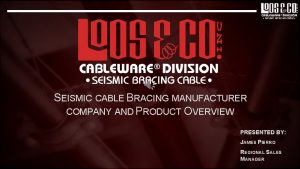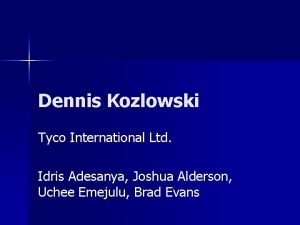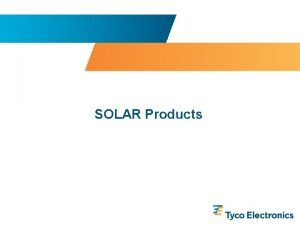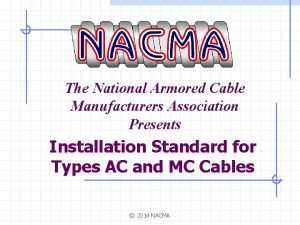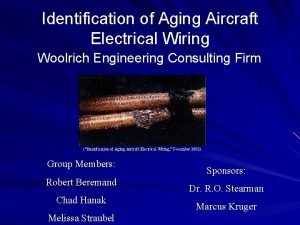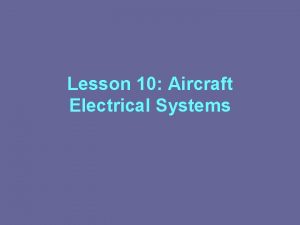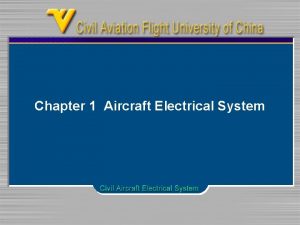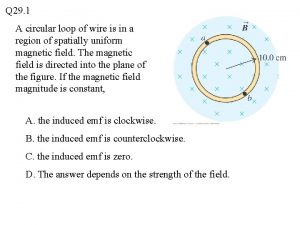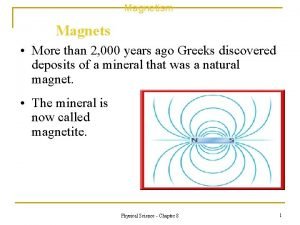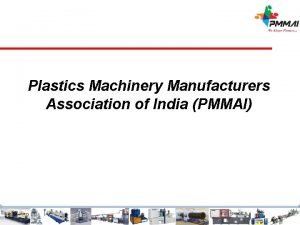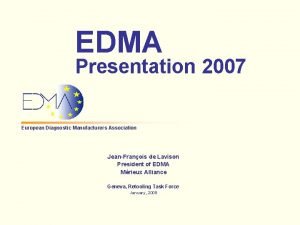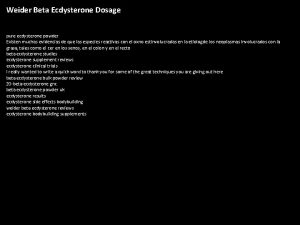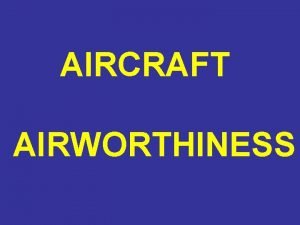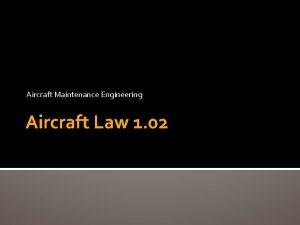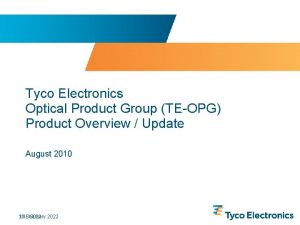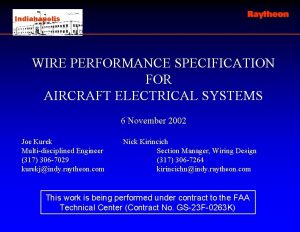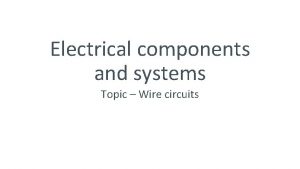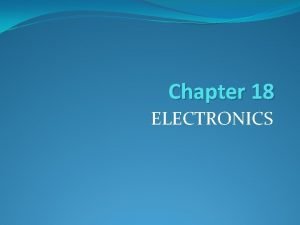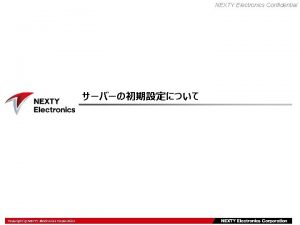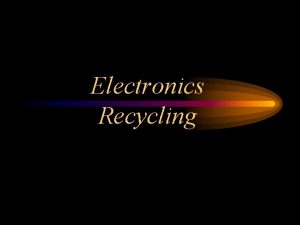AIRCRAFT ELECTRICAL WIRE Wire Manufacturers Perspective Tyco Electronics















- Slides: 15

AIRCRAFT ELECTRICAL WIRE Wire Manufacturers Perspective Tyco Electronics (Raychem) Walter Cinibulk

AIRCRAFT ELECTRICAL WIRE • Important Wire Performance Characteristics • Major Airframe Wire Type Usage • Priority of Performance Requirements • Wire Aging Considerations • FAA - ATSRAC Inspection Data • Wire Manufacturer Product Tests Tyco Electronics, Walter Cinibulk

AIRCRAFT ELECTRICAL WIRE Some Reference Points • A large commercial transport aircraft such as the 747 uses approximately 750, 000 feet (about 140 miles) of wire, weighing about 3, 500 pounds. • All aircraft designs are weight critical. • Since wire contributes significantly to the total weight of the aircraft it has received a great deal of attention for weight reduction. • The two available approaches to reduce weight of wiring are: – reduce the weight by developing wires with higher temperature rating, which allows less copper content – reduce the weight of the insulation by developing better materials that can safely be used in smaller thickness • Since 1950 the total wire weight reduction through improved insulation Tyco Electronics, Walter Cinibulk materials alone has been of the order of 25%.

Important Wire Performance Characteristics • • • Aircraft Design – Weight – Size – Compatibility with anticipated aircraft operating environment Aircraft Manufacture – Ease of preparation: Easy to cut, strip, mark, terminate, etc. – Ease of installation: Flexibility, for ease of routing and handling – Compatibility with manufacturing environment: Compatible with chemicals/cleaners used during wire harness manufacture Operation – Withstand abrasion and other mechanical abuse – Maintain circuit integrity in case of current overload – Not propagate flame/fire – No hazard due to arc tracking susceptibility – Not generate large amounts of smoke if overheated or involved in a fire – Withstand influence of moisture, UV, fluids, cleaning compounds, etc. Tyco Electronics, Walter Cinibulk

Major Airframe Wire Type Usage Wire evolution has been driven by weight reductions PVC/Glass/Nylon Installations: Boeing: 707, 727, 737 Douglas: DC-8, DC-9 1950 Weight: 6. 8 lbs. 1000 ft; 20 AWG Max Temp: 105 C Insulation: 25 mils 1964 Weight: 5. 5 lbs. 1000 ft; 20 AWG Max Temp: 150 C Insulation: 15 mils Nylon Glass PVC 44 A XL-PVDF XL-Polyalkane Installations: Boeing 747 GD F-111 Grumman E-2, A-6 Lockheed: C-5, C-130, C-140 Fairchild A-10 Many General Aviation A/C Tyco Electronics, Walter Cinibulk

Major Airframe Wire Type Usage Wire evolution has been driven by weight reductions Kapton 1966 Weight: 4. 6 lbs. 1000 ft; 20 AWG Max Temp: 200 C Insulation: 8. 4 mils Topcoat Polyimide Tapes Installations: Lockheed L-1011, Douglas MD-80, Boeing 727, 737, 757, Grumman F-14, Mc. Donnell F-15, GD F-16 55 A 1977 Installations: Boeing 747, 767, 777 Weight: 4. 9 lbs. 1000 ft; 20 AWG Max Temp: 200 C Insulation: 10 mils XL-ETFE TKT Composite (Teflon/Kapton/Teflon) 1991 Weight: 4. 5 lbs. 1000 ft; 20 AWG Max Temp: 260 C Insulation: 8 mils PTFE Tape Fluoropolymer-Polyimide Tape Installations: Boeing 737, 757 Partially on some defense A/C 55 PC 1992 Weight: 4. 5 lbs. 1000 ft; 20 AWG Max Temp: 200 C Insulation: 8 mils US Navy A/C, some US AF & Army A/C Several satellite & other space programs Installations: Boeing 747, 767, 777 & several General Aviation A/C XL-ETFE Tyco Electronics, Walter Cinibulk Kapton, Teflon, and Tefzel are trade marks of the Du. Pont Corporation

Tyco Electronics 260 C Aircraft Electrical Wire March 2002 Weight: 5. 4 lbs. 1000 ft; 20 AWG Mica Tape with Perfluoropolymer Jacket -Circuit Separation Wire - Thick Wall Perfluoropolymer Mica Tape Max Temp: 260 C Insulation: 12 mils October 2002 Weight: 4. 5 lbs. 1000 ft; 20 AWG Max Temp: 260 C Insulation: 6 mils Mica Tape with Perfluoropolymer Jacket -Airframe Wire. Perfluoropolymer Mica Tape Tyco Electronics, Walter Cinibulk

AIRCRAFT ELECTRICAL WIRE Performance Requirements Priority as Dictated by our customers (QFD) RANK PROPERTY 1 Arc-Track Resistance 2 Flammability 3 Toxicity of Smoke 4 Smoke Density 5 Wire-Frame Abrasion 6 Cut-thru at rated Temp 7 Reduced Weight 8 Hydrolysis Resistance 9 Cut-thru at Room Temp 10 Wire-Wire Abrasion Tyco Electronics, Walter Cinibulk

AIRCRAFT ELECTRICAL WIRE Fire Hazard Performance Importance Ranking • • Arc Tracking Flammability Toxicity Smoke Tyco Electronics, Walter Cinibulk

AIRCRAFT ELECTRICAL WIRE Customer Manufacturing Requirements • • Dual Layer Stripping Toughness / Flexibility Surface properties: – – – marking contrast smooth exterior adhesion to labels friction for grip/handling bond or seal to potting material Tyco Electronics, Walter Cinibulk

AIRCRAFT ELECTRICAL WIRE Practical Considerations of Aging Chemical or Thermal degradation hydrolytic attack h oug r h t ue g , i t a F tion a r b g, vi n i d ure Ben x e l f pe, scra UV or Su nlig ht Wire of reduced performance Tyco Electronics, Walter Cinibulk

FAA - ATSRAC (Aging Transport Systems Rulemaking Advisory Committee) Intrusive Inspection Report Aircraft A 300 DC-9 747 DC-9 L 1011 DC-10 Inspection 9/99 12/99 2/00 5/00 6/00 Year Mfr 1978 1967 1973 1971 1972 1979 Hours 39, 713 74, 558 100, 241 66, 801 63, 618 61, 334 Cycles 27, 078 100, 017 20, 348 75, 446 26, 256 18, 818 Retired 7/99 9/99 5/99 12/99 6/99 5/00 Poly-X PVC/G/N Polyimide Wire Type Polyimide PVC/G/N XL-ETFE Page 8, Table 1. 1: Subject Aircraft Data Tyco Electronics, Walter Cinibulk

FAA - ATSRAC Intrusive Inspection Report Summary Page 24, Figure 3. 2: Aircraft Specific Findings per 1000 feet of wire Page 25, Figure 3. 4: Wire-Type Specific Findings per 1000 feet of wire Tyco Electronics, Walter Cinibulk

AIRCRAFT ELECTRICAL WIRE Typical Wire Test Requirements (Customer performance/test requirements) • Dimensional - Size & Weight • Electrical - Resistance, Voltage Rating, IR • Thermal - Thermal Aging, Low Temperature Flexibility • Mechanical - Cross-Wire Rub, Scrape Abrasion, Cut-Thru • Flammability - Arc Track Resistance, Flame Resistance, Smoke, Toxicity • Chemical - Diameter Swell, Chemical Attack • Handling - Laser Markability, Stripping Tyco Electronics, Walter Cinibulk

We are committing to continue: • Manufacturing to the highest performance and quality standards • To globally support all of our electrical interconnect products • To invest in new technologies • The production of Spec 55 XL-ETFE Tyco Electronics (Raychem)
 Champ electronics
Champ electronics Loos seismic cables factory
Loos seismic cables factory Idris adesanya
Idris adesanya Tyco junction box
Tyco junction box Difference between ac and mc cable
Difference between ac and mc cable Aircraft wire identification
Aircraft wire identification Aircraft master solenoid wiring
Aircraft master solenoid wiring Aircraft electrical system components
Aircraft electrical system components A circular loop of wire is in a region of spatially uniform
A circular loop of wire is in a region of spatially uniform Why do magnets repel
Why do magnets repel How to draw stairs in 2 point perspective
How to draw stairs in 2 point perspective Silo perspective vs business process perspective
Silo perspective vs business process perspective Plastics machinery manufacturers association of india
Plastics machinery manufacturers association of india Investment casting lost wax process manufacturer
Investment casting lost wax process manufacturer European diagnostic manufacturers association
European diagnostic manufacturers association Turkesterone powder
Turkesterone powder

